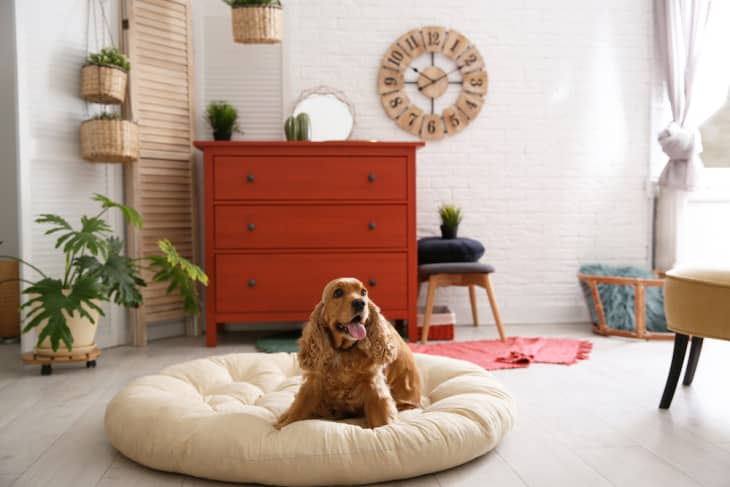6 Pet-Friendly Design Tips For Your Home That Don’t Compromise Aesthetic

As the COVID-19 pandemic continues to rage on, one particular practice has seen an uptick in quarantine: pet adoptions. Pet adoptions—more so than baking bread and tie-dying pajamas—have skyrocketed in quarantine. According to a report in the Los Angeles Times published in April, shelters and rescue organizations across the U.S. have reported an “unprecedented interest” among consumers to foster furry companions such as dogs, cats, and rabbits as people spend more time at home in an effort to curve cases.
Furry companions are the best companions. However, furry companions tend to chew, claw, and shed all over the place. Yes, Max has the cutest little teeth, but it isn’t so cute when the teeth are gnawing on the furniture that you splurged on. Well, there are pet-friendly ways for new pet parents to design their living spaces without compromising design and aesthetic. Alessandra Wood, VP of Style at Modsy, an online design interior service, shares six expert tips with Apartment Therapy on how to pet-proof your home from a design perspective below.
1. Opt For a Tanned Leather Couch
Wood maintains that, much like a leather handbag, a leather couch can age quite beautifully, too. A cognac colored leather sofa can sustain accidents and those “scratch-to-get-comfortable sessions” from our furry friends—and still look warm, rich, and vintage. Plus, it’ll be easier to vacuum out any shedding fur.
2. Have a Designated Area For Pet Toys
Designate an area to keep pet toys to avoid clutter. “Coco has a plush little igloo where she can safely hide and snuggle and we also use it as a place to put all her toys,” Wood says of her dog. Low baskets are ideal options, so the pets can “self serve” their toys from the basket.
3. Invest in Two Vacuums
Wood suggests investing in two vacuums: one big one for deep cleanings and a smaller rechargeable handheld one to vacuum fur throughout the week. She cites the Dyson Animal as an ideal, long-lasting option to pick up fur. She says, “Make it part of your routine so your home feels fresh and clean all the time.”
4. Avoid Dark Colors
While people believe that dark fabrics and rugs mask spills and dirt, they can actually highlight stains and weigh the room down. “Instead of trying to mask potential accidents with dark colors, opt for a multi-color patterned rug,” Wood says. “The pattern and color will help hide any stains that you can’t get out, while adding life to your space.” Wood maintains that grays are ideal to prevent the room from feeling light—without being a stain magnet.
5. Give Your Pet Easy Access to Certain Areas
For pets that have a hard time jumping, invest in items that make access to the sofa or bed easier. “At one point I had pet stairs for little Coco, but they were such an eyesore and I stubbed my toe on them regularly,” Wood says. Instead, Wood added a low ottoman for easier access and a rug for traction. She explains, “Two key things I’ve learned that make it easier for a pup jump are: traction and shorter hops.”
6. Choose Chew-Proof Furniture
Many young pups go through a chewing phase. In turn, opt for furniture made from chew-proof materials. Rather than furniture with wooden legs, opt for something with metal legs or framing to curb your furry companion’s desire to chew on the home decor.